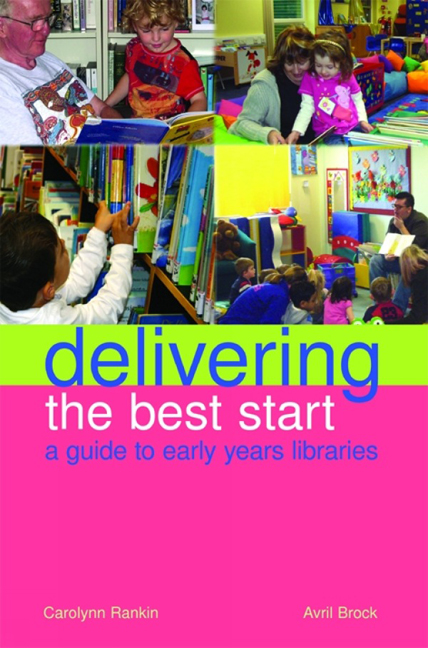Book contents
- Frontmatter
- Contents
- Preface
- Introduction
- Acknowledgements
- 1 Take them to the library – setting the scene
- 2 People and partnerships, skills and knowledge
- 3 Buildings, design and space
- 4 Resources for early years libraries – books, toys and other delights
- 5 Reaching your audience – the librarian's role
- 6 Planning
- Appendix: Early Years Library Services fit with central provision
- References
- Index
6 - Planning
Published online by Cambridge University Press: 08 June 2018
- Frontmatter
- Contents
- Preface
- Introduction
- Acknowledgements
- 1 Take them to the library – setting the scene
- 2 People and partnerships, skills and knowledge
- 3 Buildings, design and space
- 4 Resources for early years libraries – books, toys and other delights
- 5 Reaching your audience – the librarian's role
- 6 Planning
- Appendix: Early Years Library Services fit with central provision
- References
- Index
Summary
Introduction
The theme in this final chapter is planning. All organizations, and indeed individuals, need to plan for their future success and sustainability. Planning is a vital activity at all levels and we discuss some of the issues associated with planning in organizations and multidisciplinary teams. Financial planning is discussed as a very important means of allocating resources to enable development. We also look at some practical aspects of project planning, as many early years librarians have opportunities to set up schemes and initiatives, often in partnership work. Impact and evaluation are also discussed, as these are important stages in the planning cycle for any project or activity. As a main theme in this book is early years literacy and the enjoyment of books, we have included a section on planning sessions for babies, young children and their families. The final sections look at planning at the individual level and we discuss aspects of continuous professional development (CPD) and developing skills for the reflective practitioner.
Organizational planning – strategic, tactical, operational
To be an effective early years practitioner and to undertake a planning role in the workplace, it is helpful to understand the ways in which your parent organization and library and information services work. In most organizations the senior managers lead formal strategic planning processes to determine long-term plans, strategies and direction for the business. In the not-for-profit sector in the UK, organizations and agencies will consider how to meet the requirements of government agendas such as Every Child Matters, Early Years Foundation Stage and The Children's Plan. Some of these current issues are discussed in Chapter 1.
The purposes of an organization are often expressed through its mission statement and corporate aims, which are then broken down into more specific objectives. Table 6.1 shows the characteristics associated with different levels of purpose in a typical hierarchical organization:
Another way of expressing this activity is by means of basic questions. At the strategic management level the question is ‘Why?’ This most senior level carries overall accountability for the success of the organization. Staff working at this level will determine the mission and the corporate aims by undertaking long-term planning and strategic development. When the direction for the organization has been determined the next basic question is ‘How will the corporate aims be achieved?’ The ‘how’ question is implemented by managers operating at a tactical level in the hierarchy.
- Type
- Chapter
- Information
- Delivering the Best StartA Guide to Early Years Libraries, pp. 145 - 166Publisher: FacetPrint publication year: 2013

